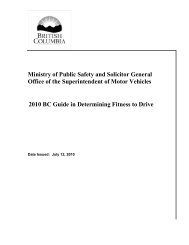BC Policing and Community Safety Plan - Ministry of Justice ...
BC Policing and Community Safety Plan - Ministry of Justice ...
BC Policing and Community Safety Plan - Ministry of Justice ...
You also want an ePaper? Increase the reach of your titles
YUMPU automatically turns print PDFs into web optimized ePapers that Google loves.
Regional integrated teams are formed to address concerns or provide services to specific regions <strong>of</strong> theprovince. For example, RCMP specialized policing units in the Lower Mainl<strong>and</strong> have been consolidated<strong>and</strong> now operate under a regional service delivery model. An example is the Integrated HomicideInvestigation Team (IHIT) which was created in 2003 to integrate homicide investigations in LowerMainl<strong>and</strong> municipalities. Other teams include the RCMP Emergency Response Team (ERT), ForensicIdentification Services, Police Dog Services <strong>and</strong> Integrated Collision Analyst Re-constructionists. The costs<strong>of</strong> these Lower Mainl<strong>and</strong> teams are shared between the participating jurisdictions according to a fundingformula.In addition to integrated teams, <strong>Policing</strong> <strong>and</strong> Security Branch supported the integration <strong>of</strong> RCMP detachments<strong>and</strong> comm<strong>and</strong> structures around the province. 4 Many <strong>of</strong> these integrated detachments deliver specializedservices on a regional basis.•¡PRIME-<strong>BC</strong> renewalIn the early 2000s, the provincial government <strong>and</strong> British Columbia’s police agencies partnered to developa shared police records management <strong>and</strong> computer-aided dispatch system connecting all municipal police<strong>and</strong> RCMP detachments. Since that time, PRIME-<strong>BC</strong> (Police Records Information Management Environmentfor British Columbia) has evolved into North America’s only multi-jurisdictional police information system.Its three interlinking components (Computer Assisted Dispatch, Records Management System, <strong>and</strong> MobileWork Stations) create a virtual, real-time connection from police communications centres to mobile units <strong>and</strong>patrol vehicles. Together, they provide police with instant information on crimes, allowing them to operate in astructured information environment that creates efficiencies <strong>and</strong> improves analytics.Now, a decade later, PRIME-<strong>BC</strong> is poised to move forward <strong>and</strong> embrace new technologies that extend beyondits original functionality. To support this necessary transformation, <strong>and</strong> to improve responsiveness <strong>and</strong> quality<strong>of</strong> service to police agencies, PRIME-<strong>BC</strong> will renew its organization <strong>and</strong> move into the next phase <strong>of</strong> its evolution.The process <strong>of</strong> renewal <strong>of</strong> PRIME-<strong>BC</strong> has the overall goal <strong>of</strong> ensuring the organization’s efficiency <strong>and</strong>effectiveness going forward <strong>and</strong> the continued delivery <strong>of</strong> fiscally responsible communication <strong>and</strong> informationservices to British Columbia’s police agencies.•¡British Columbia Provincial <strong>Policing</strong> St<strong>and</strong>ardsAs noted, one <strong>of</strong> the director <strong>of</strong> police services’ specific functions is to inspect <strong>and</strong> report on the quality<strong>and</strong> st<strong>and</strong>ard <strong>of</strong> policing <strong>and</strong> law enforcement services delivery. 5 Recently, the director’s responsibilitieswith respect to policing st<strong>and</strong>ards were enhanced. Amendments to the Police Act were brought into forcein January 2012 which established the authority for the director to set binding provincial policing st<strong>and</strong>ardsfor all police agencies in British Columbia. Initially, the scope <strong>of</strong> this authority included setting st<strong>and</strong>ards forpolice training, the use <strong>of</strong> force, <strong>and</strong> places <strong>of</strong> detention, <strong>and</strong> equipment <strong>and</strong> supplies to be used in relation topolicing <strong>and</strong> law enforcement. Recently the scope was broadened to include setting st<strong>and</strong>ards related to datacollection, cooperation between police agencies <strong>and</strong> the independent investigations <strong>of</strong>fice as well as cooperation<strong>and</strong> coordination among police agencies on complex investigations.This new framework establishes a clear authority for the provincial government to set binding provincialpolicing st<strong>and</strong>ards that apply to all police agencies in the province, <strong>and</strong> can be easily amended to respond tochanges in the policing environment.4 Examples include the integration <strong>of</strong> detachments in Vernon/North Okanagan (Vernon,Coldstream, Enderby, Armstrong, Spallumcheen, Lumby <strong>and</strong> Falkl<strong>and</strong>); Boundary (Gr<strong>and</strong> Forks<strong>and</strong> Midway) <strong>and</strong> the Upper Fraser Valley (Chilliwack, Agassiz, Boston Bar <strong>and</strong> Hope).5 Police Act, R.S.B.C. 1996, c.367, s. 40 (1) (a)16BRITISH COLUMBIA POLICING AND COMMUNITY SAFETY PLAN
















